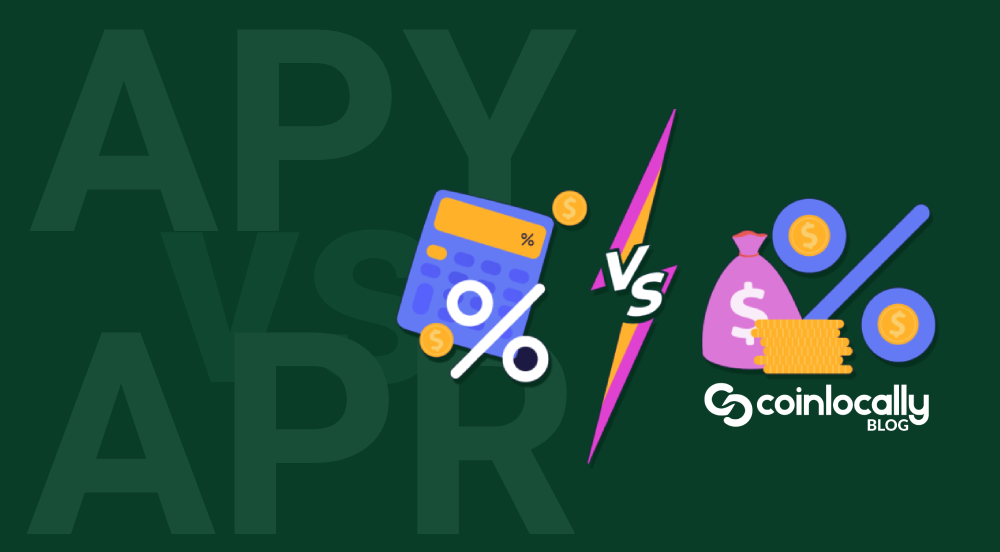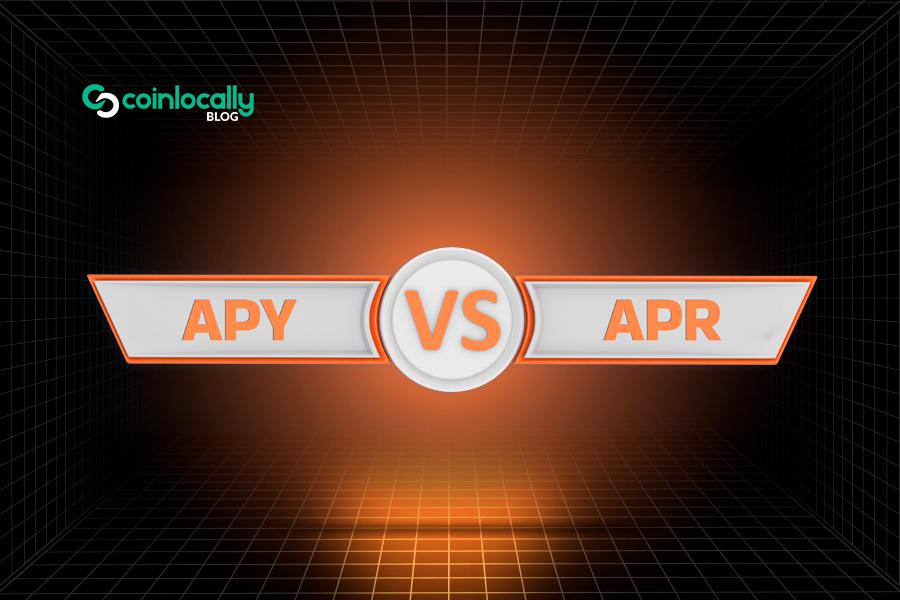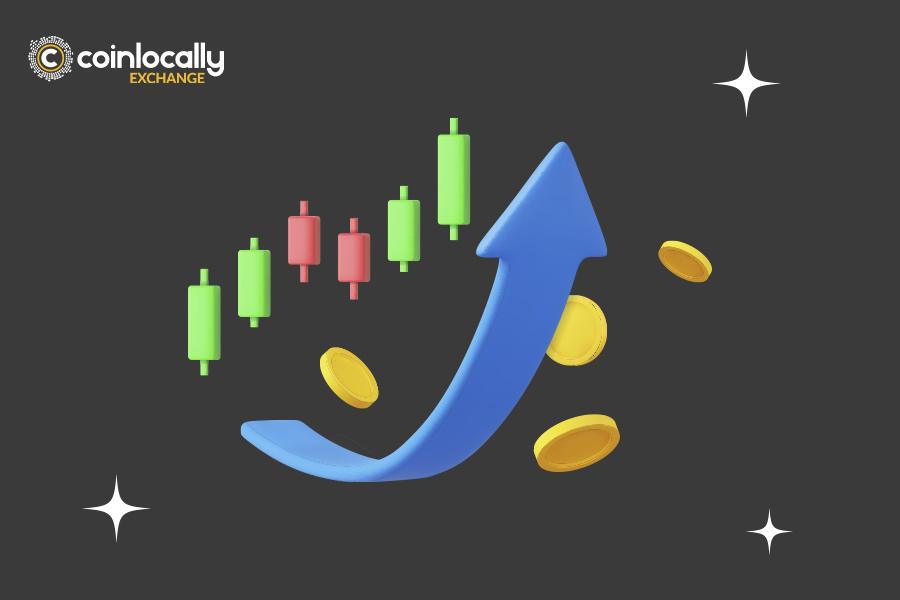When you compare financial products—such as loans, savings accounts, or cryptocurrency platforms—you will often encounter two commonly used terms: APY and APR. While they may sound similar and both involve percentages, APY vs APR represents two very different concepts. Understanding how they work is essential for anyone making informed decisions about borrowing or investing money.
This article breaks down what APR and APY mean, how they are calculated, their key differences, and when each applies. By the end, you’ll have the knowledge you need to make smarter financial choices, whether you’re opening a savings account or considering a crypto yield platform.
Table of Contents
What Does APR Mean?
APR, or Annual Percentage Rate, refers to the total cost of borrowing money over a year. It includes the interest rate charged on the principal plus any fees or additional costs associated with the loan. APR does not consider compounding, which means it gives you a straightforward look at how much borrowing will cost you annually.
APR is commonly used in lending products such as:
- Credit cards
- Personal loans
- Mortgages
- Auto loans
For example, if you take out a $10,000 loan with a 6% APR, you’ll pay $600 per year in interest. If lenders charge loan origination fees, they include those fees in the APR calculation, providing a more accurate representation of the loan’s overall cost.
What Does APY Mean?
APY, or Annual Percentage Yield, shows how much you earn (or pay) on an investment or savings product over a year, taking compound interest into account. Unlike APR, which focuses solely on the interest rate, APY shows how often interest gets added to your balance. This frequency significantly influences your overall returns.
APY is commonly used in financial products such as:
- Savings accounts
- Certificates of deposit (CDs)
- High-yield savings accounts
- Crypto staking and DeFi platforms
Suppose you deposit $10,000 in a savings account that pays 5% APY. Thanks to compounding (typically monthly or daily), you’ll earn slightly more than $500 by the end of the year.
APY vs APR: The Core Differences
To better understand APY vs APR, let’s explore their main differences:
1. Compounding
- APY includes compounding. This means your interest earns interest, increasing your effective yield.
- APR does not include compounding. It’s a flat rate representing only the basic cost of borrowing, not the effect of accumulating interest.
This is perhaps the most significant distinction. If two products advertise the same nominal interest rate but one quotes APY and the other APR, the APY product will yield more due to compounding.
2. Use Cases
- APR is mainly used in loans and credit products. It helps consumers understand how much they’ll pay when borrowing.
- APY is used in deposit or investment products. It helps consumers compare how much they can earn on their money.
3. Inclusion of Fees
- APR usually includes fees (like loan origination or processing fees), giving borrowers a clearer picture of the total borrowing cost.
- APY does not include service fees, so while it tells you the yield from interest, it might not represent the entire cost or net return if fees apply.
4. Calculation Formula of APY vs APR
APR and APY are calculated differently. Here’s a simplified look:
- APR = Interest Rate + Fees
- APY = (1 + Periodic Interest Rate)ⁿ – 1
(Where “n” is the number of compounding periods per year)
As you can see, APY’s formula is more complex because it includes the effect of compound interest.

Why APY vs APR Matters
Understanding the distinction between APY and APR is crucial for both savers and borrowers.
For Borrowers
When taking out a loan, comparing APRs allows you to choose the most cost-effective option. A loan with a low interest rate but high fees might cost more than one with a higher rate but fewer fees. Always look at the APR to evaluate the actual cost of borrowing.
For Savers and Investors
When you put money into a savings account, CD, or crypto staking pool, APY shows you the actual return, taking compounding into account. Even a small difference in APY can lead to significant gains over time, especially if your earnings are compounded frequently (daily or monthly).
In Crypto and DeFi
In decentralized finance (DeFi), platforms often promote high yields using APY. However, users should be cautious. Some platforms calculate APY using daily compounding assumptions that may not reflect actual payout structures or fees. When a platform advertises an APR, it usually means that it does not automatically compound interest. Instead, you need to reinvest your earnings manually to benefit from compounding.
Real-World Example
Imagine two savings accounts:
- Account A: Offers 5.00% APR with no compounding
- Account B: Offers 5.00% APY with monthly compounding
If you deposit $1,000 each, Account B will yield more at the end of the year due to the compounding effect, even though both seem to have the same interest rate.
This example highlights how APY gives a more realistic picture of your earnings.
Which Should You Use: APY vs APR?
The answer depends on your financial goal.
- If you’re borrowing money, look at the APR to determine the total cost of the loan over time. This will help you compare loan offers more accurately.
- If you’re saving or investing, focus on the APY to gauge the actual annual return, considering the effects of compounding.
Consumers engaged in borrowing and investing must understand the relevant metrics and know when to apply each.
Final Thoughts on APY vs APR
While APY and APR may seem like financial jargon, they carry real weight in your financial life. Whether choosing between two loan offers or comparing savings accounts, knowing the difference between APY vs APR empowers you to make informed decisions.
APY is best when you’re looking to maximize earnings through compounding interest, such as in a savings account or DeFi protocol. APR is the go-to metric for evaluating loans, mortgages, and credit card offers where total borrowing costs matter.
Take a moment to read the fine print, ask questions, and compare offers using the correct metric. Armed with this knowledge, you can actively grow your savings and effectively reduce your debt.




